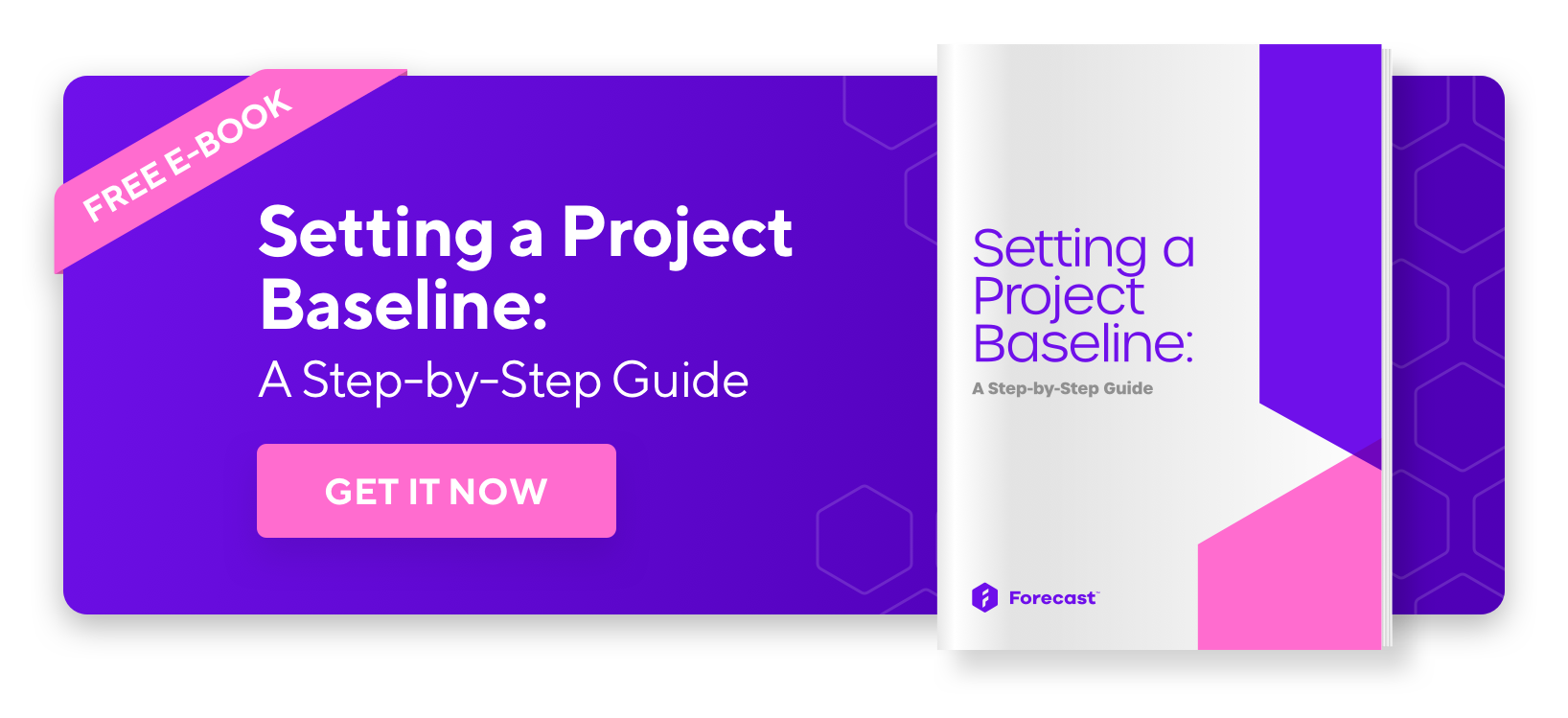Guide: How to Set a Project Baseline
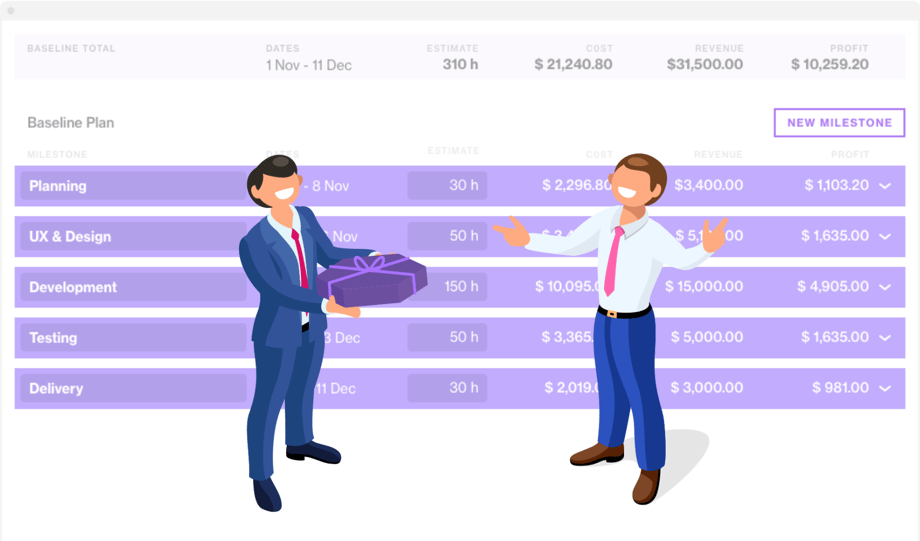
1 in 6 IT projects have a cost overrun of 200%. More often than not, it’s a sign that the baseline project plan wasn’t realistic. If you’re involved in project management, you know how difficult it is to create a project baseline and then meet the original objectives of scope, schedule, and cost.
This is especially true in the backdrop of the pandemic, when 88% of remote workers face inconsistent leadership and miscommunications with other team members. The Account Manager sells a boat, the Project Manager plans to build a bridge across the river. Communications like this cause otherwise profitable projects finish up on the rocks.
This guide is for everyone who would love to know how to baseline a project plan, whilst aligning everyone’s expectations and centering around the same goal. If you're on the go, download it here:
- Project baseline in a nutshell
- The importance of having a baseline project plan
- Types of project baselines
- Challenges in baseline project planning
- Building a project baseline
What is a Project baseline?
What is a project baseline? By definition, a baseline in project management is a plainly outlined starting point for your project plan. In other words, a baseline is the initial plan you define together with stakeholders, bringing to light the project expectations and deliverables. When approved, it becomes a point of reference against which you can measure the project’s progress over time. Here’s a baseline project plan example in Forecast:
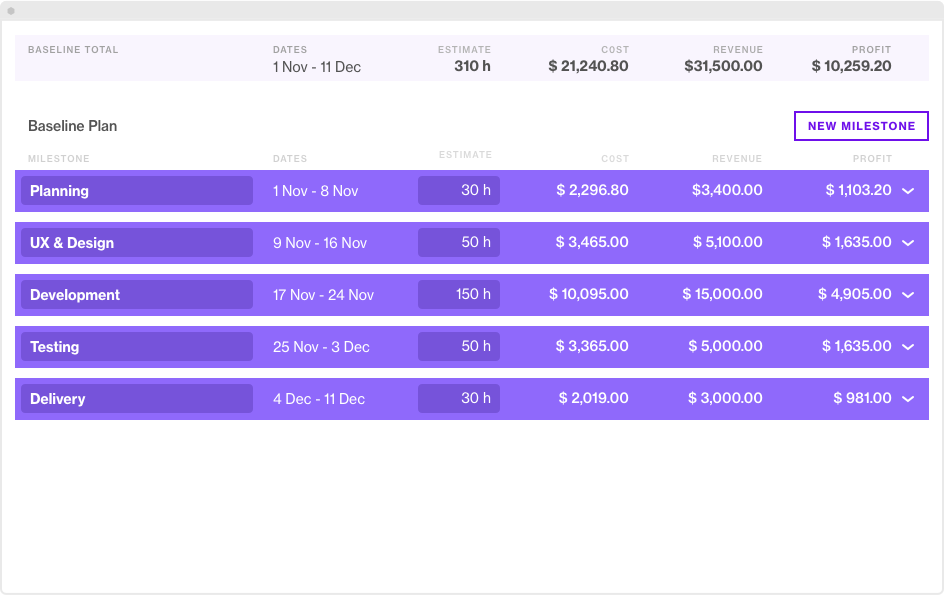
A baseline project plan then answers whether you’re likely to succeed, taking into account the initially agreed upon timeline and price. This will be your touchstone every time there’s a need to carry out project evaluation.
Baselining is extremely beneficial in cases when you know requirements will change before the ink is dry on your statement of work. When used for project monitoring and control, it will reveal how change affects key project metrics and if the project budget and scope should be re-negotiated. In addition, a project baseline plan always makes change control more efficient, as it helps project managers get their point across in numbers, when changes come in.
The importance of having a baseline project plan
Our in-house research has shown that 71% of tasks are created after the project’s start date. It’s a clear indication that scope creep hasn’t gone anywhere and is pretty widespread among professional services companies. A project baseline plan helps project managers set a perimeter and guardrails nobody can cross without discussing it in the first place and illustrates if change is feasible.
In addition, a solid initial plan is one way you can highlight disconnects and inconsistencies between the sales and project teams early on. It’s an essential part of project initiation to keep everyone in the loop regarding cost, schedule, scope, and roles on the project. A project management baseline aligns the teams around what they’re going to build.
Without a project baseline plan, it’s impossible to understand if the project is profitable or not. Baseline is not a standard to only measure a project’s progress, but also a way to predict project margins, keep fingers on the pulse of earned value, and report numbers (that don’t lie) to C-level management. Read on about the five reasons why you need a baseline here.
Types of project baselines
To evaluate different aspects of the project, three types of baselines in project management are recognized - scope baseline, schedule baseline, and cost baseline. Here is how and what they’re used for:
1. Scope baseline
The scope baseline is your approved scope statement. It’s a detailed set of project requirements divided into milestones and tasks that provides a comprehensive snapshot of project deliverables. Scope baseline is used as a basis for comparison between the initially approved project deliverables and the actual project performance.
2. Schedule baseline
As simple as that, the schedule baseline is the approved project schedule. It’s the project timeline with start and end dates, assigned roles, and estimates that you were able to build with the knowledge you had before the project began. Schedule baselines are then used to calculate the variance between planned and actuals. For example, if a milestone was planned for 2 weeks, but it took 3 weeks to complete during execution, there is a 1 week variance, eventually meaning 1 week delay in the project schedule.
3. Cost baseline
The cost baseline answers the question: How much will the project cost? In other words, your approved project budget. In turn, schedule baseline helps determine when this money will be spent.
Each of the three baseline types above can reveal useful trends about projects when they’re in progress. All together they contribute to the performance measurement baseline.
Challenges in baseline project planning
Despite the importance of creating project baselines, the process is still beset by many challenges and skepticism around planning. If you look into how project managers all over the world currently work with baselines, you’ll notice a trend. They take a snapshot of the initial plan across each type of the baseline, keep it somewhere at the back of their drawers, and call it up to get an idea if they’re on track. Then they’ll spend days translating the variance they see on paper into actual numbers.

Building a project baseline
To create a baseline that works for you, not against you, I suggest looking at some of the best practices in project management that take much of the pain and chaos out of baselining a project. However, it means that sooner or later, you’re going to need the right software.
According to PMI, 66% of companies leveraging project management software delivered projects within their original budget, compared to 47% of businesses running their project operations without a project management tool. This is true, but not every software caters to the need of proper project tracking, and it’s difficult to find a platform with an end-to-end perspective to stay on top of your scope, schedule, and cost.
Since we drink our own champagne, I’ll show you the best Forecast can do to end your planning and re-planning nightmares. For visual learners, I’ll use some screenshots of the platform as well, so you can follow the thought process easily. Let’s dive in, shall we?
First things first, the way you create your project baseline depends on your specific use case. Typically, professional services companies run Time & Material or Fixed Price projects. In both cases, baseline will be beneficial for everyone’s alignment around project price and scope.
Let’s imagine that one of your account executives has sent out a project proposal to the prospect and received green light. At the moment, you have to plan out a Time & Material project that needs to be finished by day X. What’s the best way to turn a proposal into a baseline plan, meet your deadline, and eventually deliver within budget?
Because your baseline will become a fixed version that defines your project scope, schedule, and budget, you’ll have to approve it with stakeholders which will seal the deal and set your baseline in concrete. It’s important to mention that this won’t be your final estimate, as changes will inevitably come in, just a fixed one.
1. Scope out the project
What does it mean, exactly? During the project initiation phase, you and your team will have to sit down to outline the project scope together. To make sure every critical point in the project is counted to be supplied, break the project down into milestones, or bigger chunks of work in the first instance. Painting with a bigger brush will be the first step in creating your scope baseline.
2. Assign roles
Right after that, you’ll have to define how much time it will take to deliver that scope of work.
Select a project estimation technique that works best for your scenario and gauge how much time each milestone can take. The schedule and cost baselines are interdependent, so if you’d like to keep track of how one influences another, it’s best to combine them in a single view.
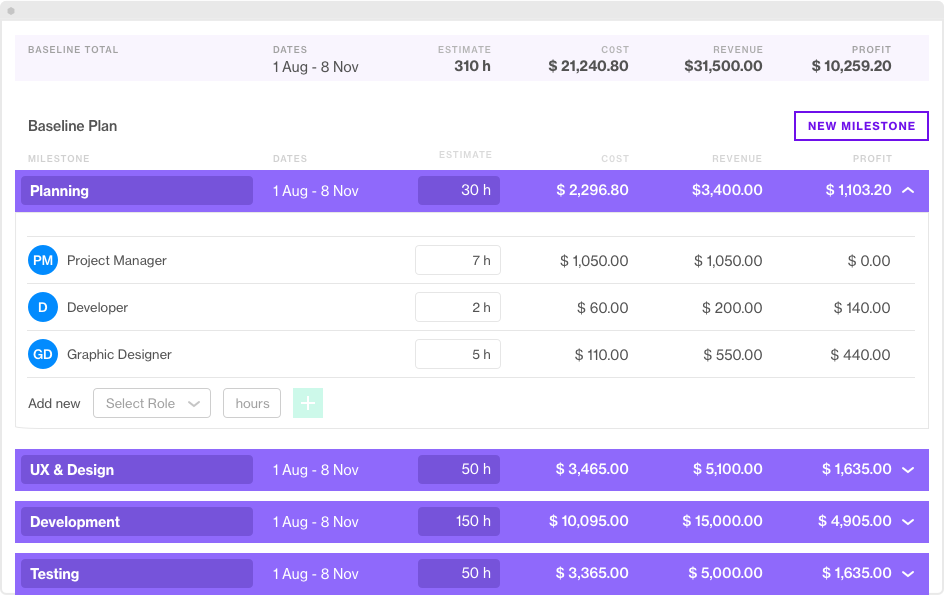
Regardless of the estimation approach you use and how detailed your initial plan is going to get, at some point you’ll have your project scope defined, being able to calculate the price based on the rate cards of your roles. To set your cost baseline, assign specific roles to complete every milestone.
Planning by roles is necessary to see what resources you’ll need to meet the initial quote. In fact, resource planning always goes hand-in-glove with scoping a project. Before drilling down to specific employees, it’s always easier to identify the roles needed for each project milestone, and move to making the next decisions from there.
Note: Given that every role has a rate card, the measurements of planned cost, revenue, and profit will be calculated automatically.
If stakeholders agree with you, that version of the project plan will become your baseline. Then working backwards from it, you can map out the whole project and resource management plan, and kick off the project.
3. Split milestones into tasks
This step is paramount for everyone to understand what they’re building. When you have the bare bones of your project, you can think small and divide them into digestible tasks. Comparing your scope to the baseline when adding bits and pieces of tasks in real time is important to make sure you don’t break the initial quote for each milestone.
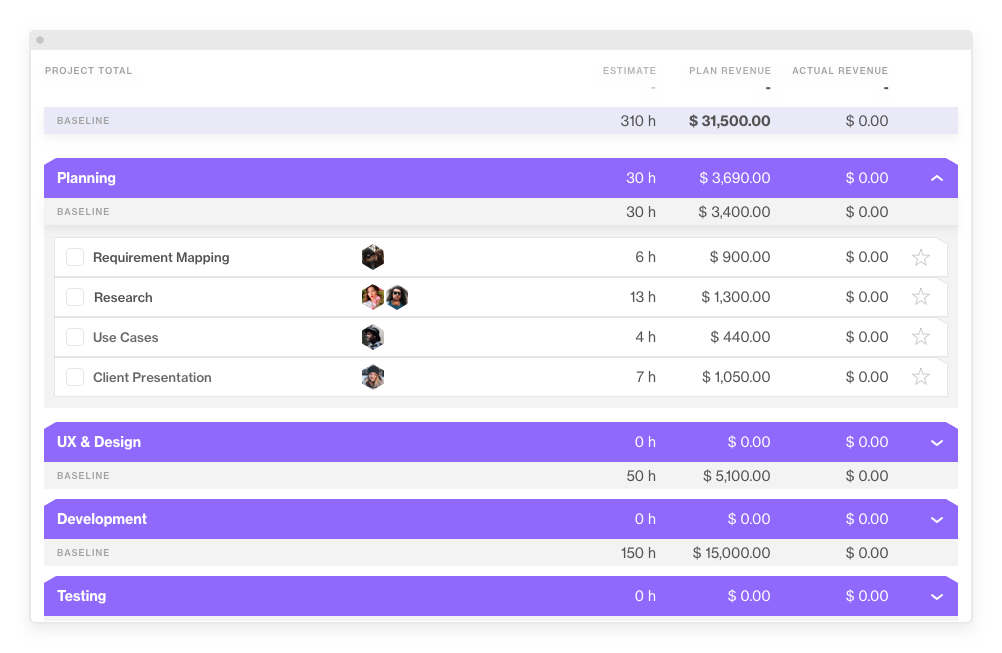
Once you’ve completed this step, it’s time to create your project timeline, assign resources, and start delivering value for your client.
Now, the only thing that’s left is to try it out in practice. This way of baselining in project management will be a godsend for professional services companies that are continuously overservicing their clients without knowing where their budgets go as time flies. To nail profitable projects, baselining of scope, schedule, and cost is a must. Without it, projects can easily go off track, and that’s not what we want, right?
You might like to read these articles on our blog..
Subscribe to the Forecast Newsletter
Get a monthly roundup of productivity tips & hacks delivered straight to your inbox
